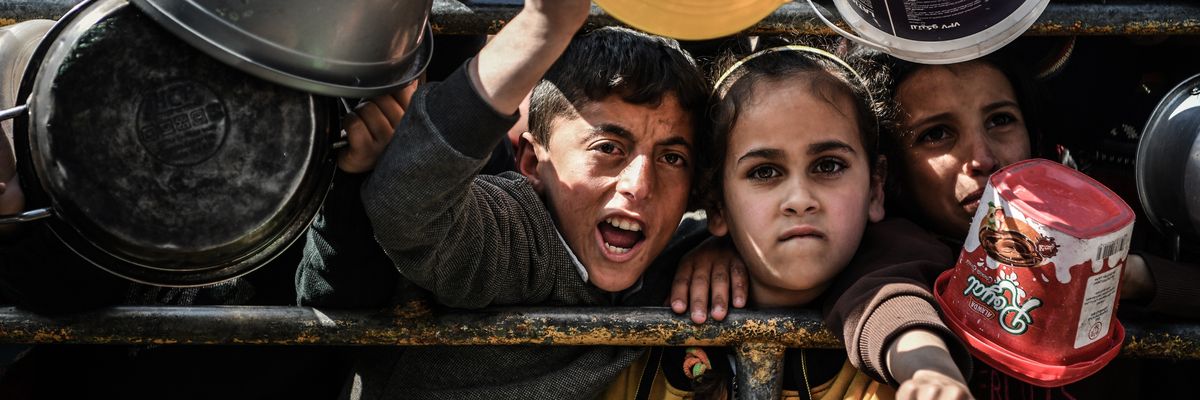
“Malnutrition among children is spreading fast and reaching devastating and unprecedented levels in the Gaza Strip due to the wide-reaching impacts of the war and ongoing restrictions on aid delivery,” UNICEF said.
OLIVIA ROSANE, COMMON DREAMS, MARCH 16, 2024
Around one-third of children under two in northern Gaza are now suffering from acute malnutrition, the United Nations International Children’s Emergency Fund announced on Friday.
That’s double the percentage of children under two who suffered from acute malnutrition in January, as the rate jumped from 15.6-31% in one month.
“The speed at which this catastrophic child malnutrition crisis in Gaza has unfolded is shocking, especially when desperately needed assistance has been at the ready just a few miles away,” UNICEF Executive Director Catherine Russell said in a statement.
“The situation is beyond catastrophic.”
The UNICEF data came from screenings it conducted with its partners in February. While the rates of malnutrition are higher in the north, no part of Gaza remains untouched. As a whole, the agency concluded that “malnutrition among children is spreading fast and reaching devastating and unprecedented levels in the Gaza Strip due to the wide-reaching impacts of the war and ongoing restrictions on aid delivery.”
A full 28% of children in Khan Younis in central Gaza have acute malnutrition, while in Rafah, around 10% suffered from acute malnutrition by the end of February. That was also double the 5% who suffered from acute malnutrition in January in the southern city. In the north, as many as 25% of children under five also suffer from acute malnutrition, up from 13%. The new figures come as humanitarian groups and U.N. agencies have been warning about potential famine in the Gaza Strip for months.
More
UNICEF also found in February that 4.5% of children in shelters and health centers in northern Gaza suffer from severe wasting, the most serious and potentially fatal form of malnutrition, for which the necessary treatment is not on hand. In Khan Younis, more than 10% of the malnourished children have severe wasting. Even in Rafah, the number of children under two with severe wasting more than quadrupled from 1% to over 4% between January and the end of February.
In total, at least 23 children have died from starvation or dehydration in northern Gaza in the last few weeks alone, UNICEF said. Israel’s bombardment and invasion of Gaza has been particularly devastating for children as a whole, killing around 13,450 out of a total death toll of more than 31,000, according to the Palestinian Ministry of Health.
“We’ve been sounding the alarm that children will die due to malnutrition and disease since the beginning of the war,” Save the Children UK said on social media on Saturday. “Our worst fears have now come true. These man-made conditions continue to deteriorate toward famine and will continue to take innocent children’s lives.”
We've been sounding the alarm that children will die due to malnutrition and disease since the beginning of the war
Our worst fears have now come true.
These man-made conditions continue to deteriorate towards famine and will continue to take innocent children's lives. #Gaza pic.twitter.com/xxDUOm2luS
— Save the Children UK (@savechildrenuk) March 16, 2024
Lucia Elmi, UNICEF’s special representative in the Palestinian territories, toldThe New York Times that children were declining at such alarming rates because the available water, bread, and flour was not enough to provide the nutrition they need.
“They need protein, they need vitamins, they need fresh products, and they need micronutrients, and all of this has been completely missing,” Elmi said last week. “That’s why the deterioration has been so fast, so rapid, and at this scale.”
Dominic Allen, the United Nations Population Fund representative for Palestine, told reporters on Friday that everyone he spoke to Gaza was “gaunt, emaciated, hungry.”
“The situation is beyond catastrophic,” he said.
Russell said that UNICEF had not been able to acquire the supplies it needed to properly treat malnourished children. Humanitarian groups have criticized Israel for making aid deliveries more difficult by searching every truck that enters the strip and rejecting whole shipments because they contained items like children’s scissors or wooden instead of cardboard boxes for toys. In multiple instances, the Israeli military has fired on on aid convoys and on people gathering to receive aid, killing scores.
“We have repeatedly attempted to deliver additional aid and we have repeatedly called for the access challenges we have faced for months to be addressed. Instead, the situation for children is getting worse by each passing day. Our efforts in providing life-saving aid are being hampered by unnecessary restrictions, and those are costing children their lives,” Russell said.
Ultimately, Russell continued, the only way to properly feed and treat Gaza’s children is for Israel to stop its attack on the strip.
“An immediate humanitarian cease-fire continues to provide the only chance to save children’s lives and end their suffering,” Russell concluded. “We also need multiple land border crossings that allow aid to be reliably delivered at scale, including to northern Gaza, along with the security assurances and unimpeded passage needed to distribute that aid, without delays or access impediments.”
Leave a Reply
You must be logged in to post a comment.